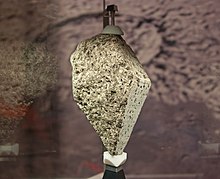Lunabas

Lunabas is the name coined by the American geologist Josiah Edward Spurr (1870-1950) in his 1945 work Geology Applied To Selenology for the basaltic rock from which the Mary of the Moon, which appears dark from the earth , should mainly consist. At the time, Spurr assumed that the mare were created by volcanic processes, similar to the flood basalts on Earth. Spurr distinguished between two Lunabas subtypes: the rock that characterizes the dark gray Mare Imbrium he called Imbas ("Imbrian-type basaltic rock") and the darker rock south of the Mare Imbrium, which he considered younger, he called Novabas ( "Tranquillitas-type basaltic rock").
According to Spurr's (from today's point of view basically correct) ideas, not only the Maria, but the entire surface of the moon were exclusively of magmatic origin. On the nature of the two geological domains of the moon, Hochländer ( Terrae ) and Maria, which can be distinguished from one another based on their brightness , Spurr concluded by analogy with magmatism on earth. This produces mainly two chemically different families of rocks, which are characterized by different brightness: SiO 2 -rich granites or rhyolites ( light ) and SiO 2- poorer basalts or gabbros ( dark ). Accordingly, he named the light rock of the Terrae lunarite .
The hypotheses developed by Spurr, which are based exclusively on remote observation of the moon and are also to be seen in the context of the current state of research (including the non-existence of impact geology ), were made possible by the geological investigations carried out from 1969 onwards as part of the Apollo and Luna program can only be partially confirmed, but he was right with the basaltic composition of the Mare rocks. However, the name "Lunabas" is no longer used for these rocks today.
Individual evidence
- ^ A b Josiah Edward Spurr: Geology Applied To Selenology. Volume II: The Features of the Moon. Science Press Printing Co., Lancaster, PA, 1945, p. 20 ( HathiTrust )
- ^ Don E. Wilhelms: The geologic history of the Moon. USGS Professional Paper 1348, Department of the Interior, US Geological Survey, Washington, DC, 1987, pp. 83 ff. ( USGS )